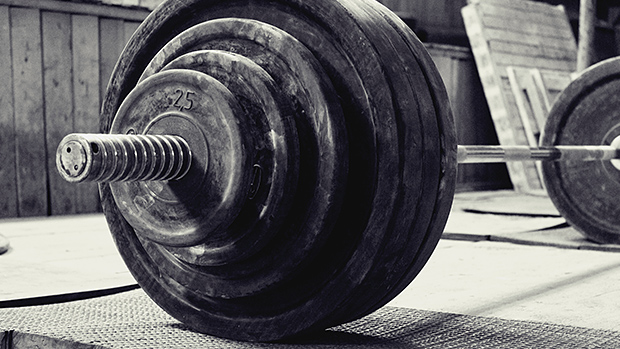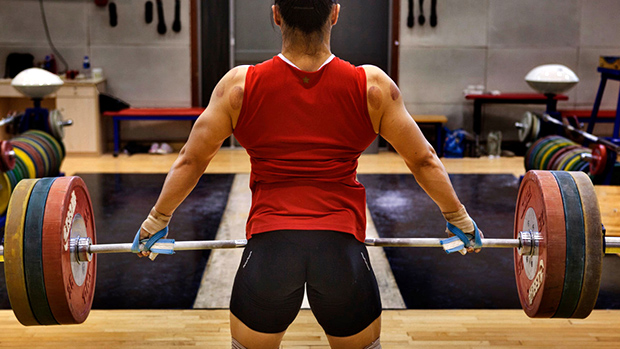Every new lifter makes pretty fast gains in both size and strength. After all, he or she went from doing nothing to do, well, something. It makes us confident that what we're doing in the gym is working. Then, we stagnate. We get stuck at medium.
Here are seven reasons this happens and how to get those gains going again.
If you don't have a logbook, get one. Here's why.
You trained chest last Monday. You did 275 for 9 reps on bench press. The next bench press session is now here. You reference your trusty logbook just in case you forgot what numbers you needed to beat.
It tells you,
"Here's your crappy numbers from the last training session. I really hope you don't suck as much today as you did last time."
At least that's the theory behind a logbook and it's definitely what mine said every time I opened it up. I knew then that I needed to suck a lot less than I sucked last time. And that if I didn't suck less, then I sucked even more suck than the last time I sucked.
Then I'd hit 275 for 10, and it'd say, "That's better... but you still suck."
That's how I grew. The logbook kept me accountable to do better. To get better. To train harder and crush my previous performances.
One of the most satisfying things in the world is opening up my logbook and trying to figure out what the damned numbers were, because when I wrote them down my hands were trembling badly from the effort. The other most satisfying feeling was writing down bigger numbers than I did last time.
If your logbook tells you in six months that you don't have bigger numbers, then you're not going to look any different than you do right now.
One of the most unproductive things you can do is study the training of a super-jacked dude and somehow arrive at the conclusion that his current training style is responsible for how jacked he is.
Anyone who develops a physique or level of strength worth admiration usually went through an evolution that molded their training into what it is today. I was lucky in my early years because I picked up some really basic principles – principles that got carved into my brain – about how I was going to grow.
Pick this weight up and do reps with it. Next week, do more reps with it than you previously did. And do this with a handful of basic movements. Do this for years on end and you'll get bigger.
And that's what I did. I picked a weight that I could do for 8 reps. Then each week I'd try to do more than 8 reps with it. When I could do 12 reps with it, I'd increase the weight.
That's all I did for 90% of the time during my first decade or more of training. I might have switched out a few things here or there, but for the most part that was all I did. My go-to movements during those years were:
- Squat
- Deficit Stiff-Legged Deadlift
- Supinated-Grip Pulldown
- T-Bar and Barbell Row
- Incline Dumbbell Press
- Bench Press
- Overhead Press (Dumbbell and Barbell)
I threw in the usual mix of curls, triceps work, dips, chins, etc., but I really stayed with progressive overload on those movements. I knew that if I could go from the 80-pound dumbbells for 8 reps on the incline bench to the 100-pound dumbbells for 12 reps, I'd get bigger. I knew that if I could go from 245 x 8 on the barbell row to 315 x 8, my back would be bigger.
That was it. A decade or longer. These days, you'd be hard pressed to get a dude to adhere to a set program for two weeks.
If you want to grow, and I mean really grow, then you need to grok some tried and true principles about muscle growth and select a few movements you intend on pounding into the dirt for about the next decade. There's no magical routine out there that's going to suddenly transform you into a beast.

During my growing years I really hunkered down into a select few movements and pounded pavement with them for a very long time. Those were the lifts that felt natural to me and that I really enjoyed doing.
Because they felt natural to me, and because I enjoyed doing them, I made fairly consistent progress. And because I made fairly consistent progress, I made some sweet-ass gains.
I bring this up because I must get a thousands questions a month from guys asking, "Can I do this? Should I do that?"
I don't know. Can you? Should you? They're questions I can't answer. But my question back to you is, "Why don't you try?" That's how you're going to find out. That's how I found out what exercises were going to be the focus of my training.
I didn't have to ask someone for permission. Hell, there wasn't even anyone to ask. I didn't get a piece of paper after reading that issue of Flex and start writing Dorian Yates a letter seeking his blessing for trying a movement he recommended.
Here are two questions you should ask yourself, though, that will help you decide – without having to ask permission:
1. Does the exercise have a high degree of potential for progressive overload?
For example, close-grip bench presses have a much higher potential for loading than triceps kickbacks. If you're a novice or intermediate, why on earth would you choose kickbacks as a preferred triceps builder when your current close-grip bench press is a weak-ass 135 pounds? You've got a lot to work with on the close grip.
2. Do I enjoy doing it?
Not everyone enjoys squats. Some people have leverages that, no matter what they change mechanically, make squats uncomfortable and hence, no fun. But maybe Smith machine squats or hack squats or leg presses do feel more natural, and maybe they feel those in their quads more.
I put very little stock into the opinions of dudes on the internet that proclaim that those aforementioned movements are "worthless," when I can't tell by looking at them if they've ever set foot into the weight room.
Anyhow, if you throw the answers to those two questions together, then you've got a nice cocktail for making some gains. Quit doing shit you hate or in general isn't productive for you just because someone on the 'net tells you that you have to.
I feel bad for many novice dudes that really want to grow. They're living in a time where there's more information on training than ever, yet guys seem more confused than ever about how to grow larger and get stronger.
A huge part of this is that sects of the lifting community love to present info in a way that reads like an excerpt from a Chinese nuclear physics class. In a lot of cases, if I didn't have a video of what they were talking about for reference, I'd have no idea what this "coach" was explaining how to do.
Take lateral raises. Do you really think that making sure your pinky is turned some specific way is the key to fixing your lagging delts? Probably not. I'm not saying movement execution isn't important. It is. But it doesn't have to be so damned complicated, either.
Here's a fairly simple way to know if your execution is pretty good:
- When you're performing a movement, do you feel the muscle you're trying to work... working?
- Do you get a strong peak contraction?
- Are you initiating the start of the movement with the target muscle?
If you answer yes to all of the above, then you're probably good to go. If you can't feel that muscle contracting forcefully, then there's probably a reason. Most of the time, it's one of these:
- You're going too heavy to sustain a mind/muscle connection.
- You're excessively dominant in another muscle group that's doing the brunt of the work in that particular movement.
- You're not initiating with the target muscle, which is probably related to the first problem.
The answer to all of this is really simple: Lighten the load or pick a different exercise.

"Volume is the driver for growth."
Yawn.
"Well Paul, there are studies that show..."
I know this may not sit well with some, but there are things studies can't account for. Research rarely studies subjects who are advanced enough in their training to make training to failure work effectively.
Training with brutally hard effort is a lost art. Not to mention, training brutally hard is naturally going to limit volume, along with eliminating junk volume as well. To keep beating this already beaten horse, brutally hard training has benefits like time efficiency and metabolic benefits you just can't get from junk volume.
Screw the studies because every study has limitations. They usually even admit that at the end. A group of college guys with 1-2 years of experience in the gym that train for 8 weeks literally has no relevance to advanced lifters. Zero. Zilch.
Instead, I'll show you in-the-trenches, real world results from training programs that don't seem to fit so neatly into any study, but nevertheless produce muscle in heaps. Doggcrapp training, for example, has produced more monsters than probably any other training methodology in play.
You know what it's built around? Training brutally hard for just a few rest/pause sets, while pushing the rep and loading numbers each and every workout.
I asked a number of really advanced guys how many true working sets they were doing for certain muscle groups during a training week. The average for legs? Six to eight sets in a training week. Total. That's quads and hamstrings combined. It sure the hell wasn't twenty, like some of the studies or "scholarly" trainers suggest.
Now if you're a beginner or an intermediate, you probably haven't cultivated the ability to train with eyeball-bleeding effort yet. And you'll probably need more volume to make up for that.
But you should still be cultivating the ability to generate that kind of "grow or die" effort every time you step into the gym – not focusing on some blanket number of sets to hit because some study told you to.

It's odd what social media has done to the lifting world. It's not unusual to find a group of clown dicks in the gym with a full camera crew, taking up whole areas of equipment to do silly-as-shit exercises in order to make a post for social media.
Their clown-dick following sees the post and then does what clown-dicks do: imitates what their clown-dick idols claim they're doing.
A few decades ago, powerlifters could compete for a very long time, at a very high level, because they had real off-seasons where they reduced the load on the bar and focused on rep sets and being smart with their joints.
Longevity isn't something a lot of guys think about these days, which is why you'll often see some behemoth dominate in strength sports for a while and then fall off due to recurring injuries. Hard to take your foot off the gas when each and every training session is based on "likes" and "views."
Physique-wise, there are men and women who basically contest-diet year round to stay in damn near "show shape" for their Instagram photo shoots. For those with truly massive followings, I get it. That's become your job, and you make a significant amount of money from it.
I can't fault anyone for trying to make a living, but if you're the part-time second shift guy at Best Buy who weighs a buck-sixty four, keeping your "shredz" for the 'gram is exactly why you're not growing.
Excluding the outliers, I've never met a single person in possession of an impressive physique that didn't spend some serious time power-shoveling food. Show me a dude who's walking around at a lean 210-225 and I'll show you a dude that spent a significant portion of his training life struggling to find the energy to tie his shoes.
My two biggest growth spurts in muscle were characterized by eating so much that I absolutely hated my life. It's true that you can't totally force-feed muscle growth, but you damn well better give it the ol' college try at some point.
The accumulation of more and more muscle proteins over time is a slow and agonizing process. It's slower and even more frustrating when you're trapped in no-man's land of "I want to be a beast, but eat like a runway model."
If you're in your 40's, like I am today, this probably isn't an intelligent or feasible option. It's not my fault that you wasted the previous years of your life avoiding the gym or eating like that model. But if you're in your teens or twenties and aren't eating in a way that frightens children, then you're missing your window for accelerated growth.
I've previously laid out some of the diets I used in my fat-boy years and read disparaging comments pertaining to them like "diabetes" and "heart attack waiting to happen." I never said it was healthy. There's nothing healthy about pushing the boundaries of food and barbells when you're trying to maximize your genetic potential.
But that's also why I get to walk around at 240 pounds now with abs, while no one can tell you lift weights when you have a T-shirt on.
There was no Facebook or Instagram during the years I built that foundation. My training and eating was dictated by my desires and goals. Not validation from a bunch of strangers voyeuring my life.
Here's what's most important if you want to get better:
Break rep PR's, break food PR's, break sleep PR's. Get comfortable with being uncomfortable when it's time to train and eat.
Stop bouncing from training program to training program every three weeks. Find six to eight basic movements that have a high degree of potential for progressive overload and get brutally strong on them for reps.
Stop worrying about what someone else is or isn't doing. It literally has zero relevance to your own training. It's also literally none of your business. You should be too damned busy eating, sleeping, and training to even notice.
Looking for motivation? Need to get your mind right when you're discouraged about a lack of progress? One of my most favorite quotes of all time about what it takes to get better was by Dr. Ken Leistner:
"I'm fond of telling doubting trainees that it's just a matter of always adding weight to the bar, adding another repetition. If you could get to the point where you're squatting 400 pounds for 20 reps, stiff-legged deadlifting 400 pounds for 15 reps, curling 200 for 10 reps, pressing 200 for 10 reps, doing 10 dips with 300 pounds around your waist, and chinning with 100 pounds, don't you think you would be big? I mean awfully big? AND strong? Obviously!"
That's all there is to it.





